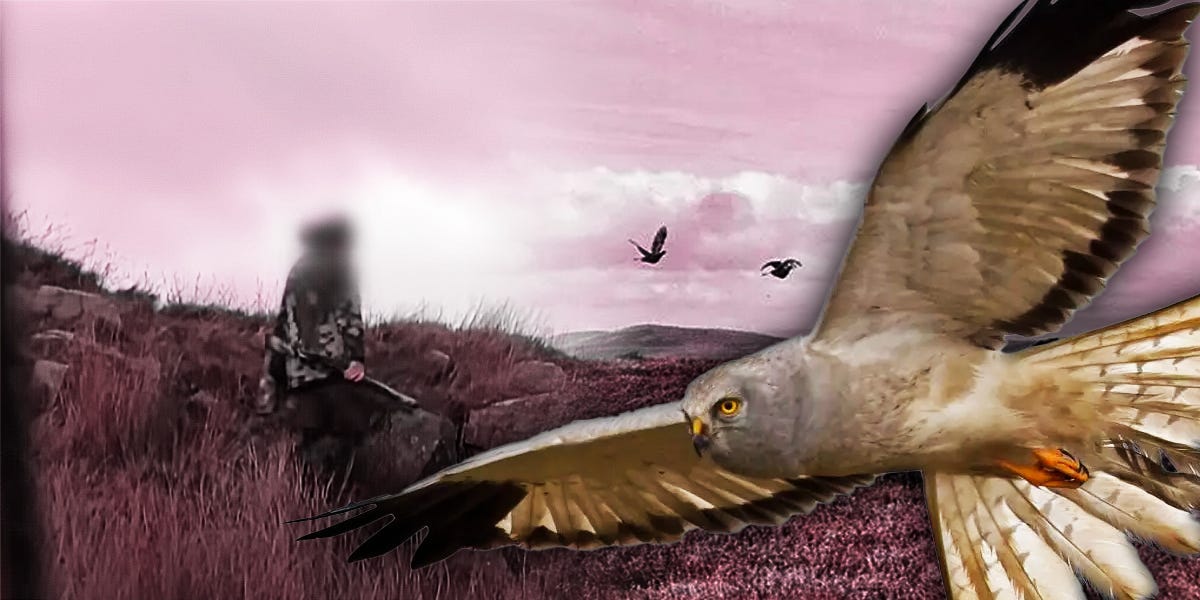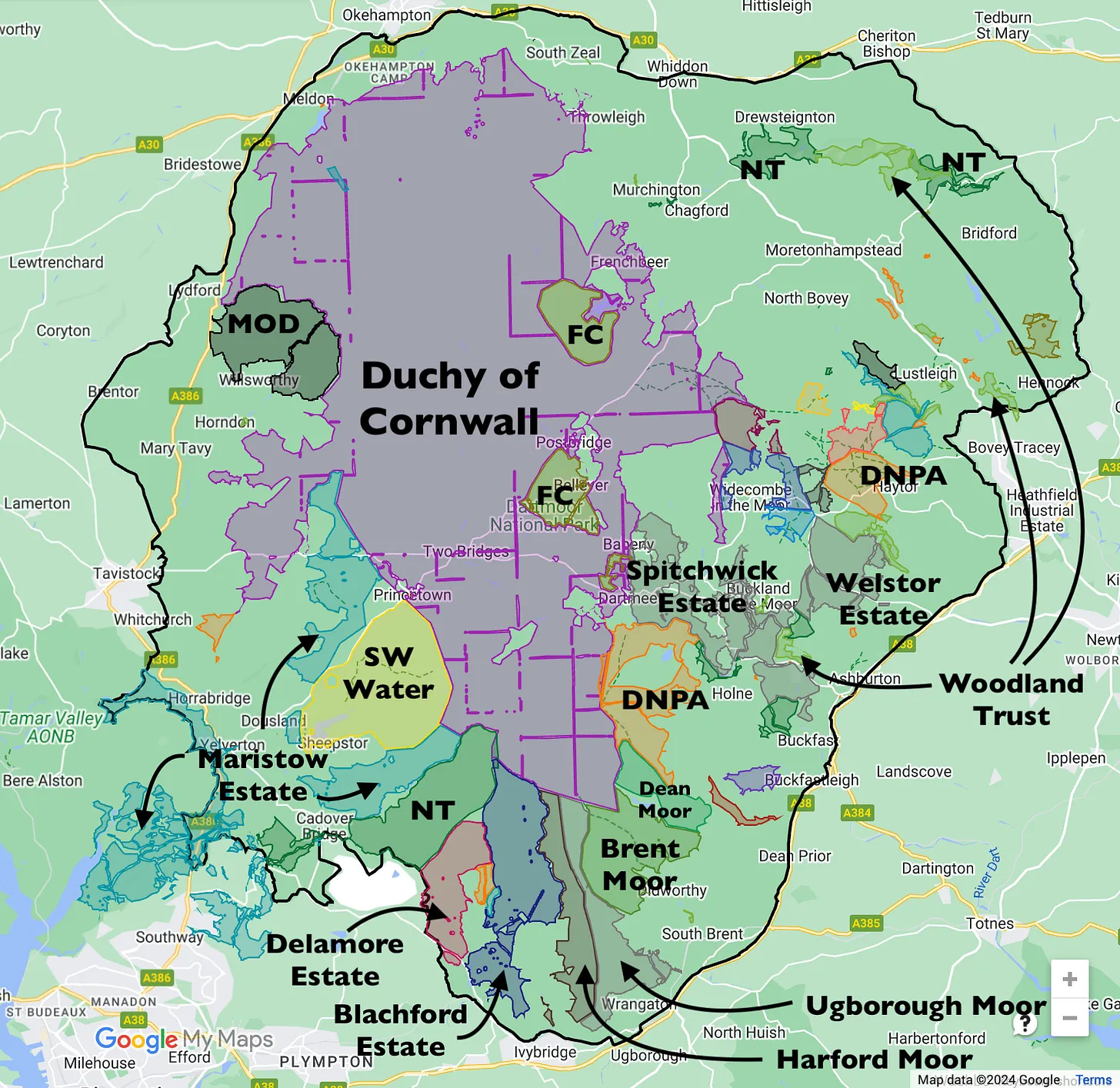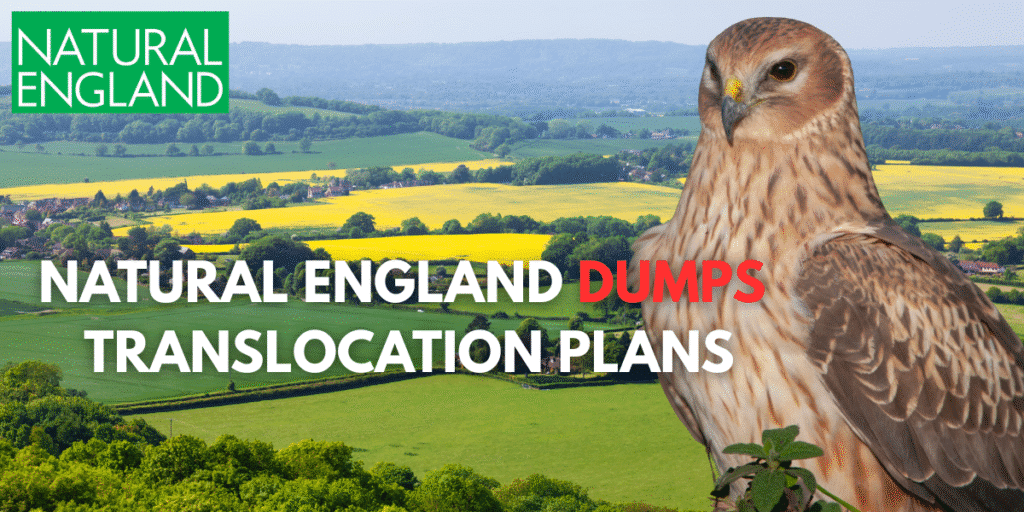“Following a thorough review, it has become clear that Natural England is no longer in a position to provide the long-term funding and resource needed to continue delivering the Hen Harrier Southern Reintroduction project, despite the progress to date. The difficult decision has therefore been made to conclude this project.”
With this pitiable ‘poverty-pleading’ disclaimer so ended part of a shameful Hen Harrier ‘brood meddling project’ designed by Natural England (NE), the government’s adviser for the natural environment in England (whose stated aim was simply to “help to protect and restore our natural world” but now also appears to be – and this is quoting from the sidebar on the NE blog – “helping to protect England’s nature and landscapes for people to enjoy.”)
That slight shift in messaging from protecting the environment to ensuring people come first, mirrors what ‘brood meddling’ was all about: (to quote NE) “taking the eggs or chicks of some Hen Harriers nesting on grouse moors into captivity, rearing them to fledging age, and releasing them back into the wild in the uplands of northern England. This reduces the density of active Hen Harrier nests on grouse moors and is thought to reduce predation pressure on red grouse during the breeding season.”
In other words, according to NE itself (which seems to be victim-blaming Hen Harriers for the illegal persecution they face), ‘brood meddling’ involves moving one of the UK’s most highly-protected but also most routinely persecuted birds of prey around the country solely to placate grouse moor owners so that both they and their complicit clientele could continue the trade in Red Grouse without a grouse-chick-eating bird of prey getting in the way of their ‘enjoyment’.
Pushing the limits of ‘conservation’
The ‘Hen Harrier Southern Reintroduction’ part of this sop to the ‘grousers’ aimed to establish a wild, farmland nesting population of Hen Harriers in the south of England. Supported by a conservation breeding programme, the project planned to introduce up to 100 juvenile Hen Harriers to a protected farmland site in Wiltshire over a five-year period. Over time, NE said just last year, “harriers released in southern England should begin to breed naturally in the wild, establishing a new self-sustaining population”.
More harriers sounds like something that would be welcomed by birders and organisations like Protect the Wild, right? We celebrate the reintroduction of Ospreys and White-tailed Eagles, so surely we would also welcome a project aiming to ‘head start’ a southern population of Hen Harriers. After all, Hen Harriers were once found in the south of England, and while ‘farmland’ is more often thought of in terms of the even rarer Montagu’s Harrier (which raised chicks this year for the first time since 2019) they do use similar habitats in Europe. Why not give Wiltshire a try…
There are several obvious problems with this ludicrous idea.
The first is that as we and many others have noted, taking chicks from Hen Harrier nests on grouse moors with the aim of establishing a breeding population in southern England (where there no grouse moors, but there are hundreds and hundreds of pheasant shoots) is pushing at the very limits of the law and what can be done in the name of ‘conservation’.
Courts in England have recognised that it is actually a breach of international legislation to remove Hen Harriers from Special Protection Areas (SPAs) that had been designated specifically for Hen Harriers (and remarkably some grouse moors where chicks were going to be taken include designated SPAs), and release them elsewhere.
The courts have also dismissed arguments that Hen Harriers’ predation on grouse chicks necessitates their removal from an SPA, as the purpose of the SPA is to protect the Hen Harrier, not the grouse moor industry.
Conservation translocation
Secondly, moving harriers around the country without fixing the reasons why the translocation is being considered in the first place, appears to also be ignoring the government’s own ‘Principles of conservation translocation’ which says under ‘5. Maximise chances of successful establishment’ (and the highlighting below is ours):
You must have a thorough knowledge of the species and its ecology to make sure previous threats that caused extinction are reduced or removed.
You should understand why the species is in decline in that habitat, so that you can remove or reduce those threats to your project.
In simple terms, the project was set up because of the very real threat to the survival of Hen Harriers because of persecution by gamekeepers – but that threat from gamekeepers on grouse moors has NEVER been removed.

‘Brood meddling’ came with a ‘gentleman’s agreement’ that if harriers were taken away and only released back on the moors after the ‘season’ ended, then they would be safe…
Of course, that isn’t what has happened at all. It has been illegal to persecute Hen Harriers (and other birds of prey) since the passing of the Protection of Birds Act 1954. Higher levels of protection were introduced under the Wildlife and Countryside Act 1981. But Hen Harriers are still routinely killed to ‘protect’ grouse (see for example Four more satellite-tagged Hen Harriers have vanished since January and Another Hen Harrier vanishes on grouse moor in Yorkshire Dales National Park).
A gamekeeper from the Coniston & Grassington Estate in the Yorkshire Dales National Park, Racster Dingwall, proved the routine nature of harrier persecution when he was recorded covertly by the RSPB discussing ‘nolling’ (killing) ‘jets’ (Hen Harriers) almost exactly a year ago.
The excellent Raptor Persecution UK keeps a rolling tally of Hen Harriers “confirmed ‘missing’ or illegally killed in UK since 2018, most of them on or close to grouse moors”. The date is important: 2018 is when NE launched the ‘brood meddling’ project and the ‘agreement’ was supposed to start. As of September 2025 the tally stands at 143.
That figure only includes the harriers that are known about of course – how many birds the likes of Racster Dingwall and his ilk have ‘disappeared’ on top of those we will never know. NE itself noted in 2023 that “Persecution remains a serious issue and needs more focus and action from the Police, businesses, landowners, and game management interests.”
There has been neither.
Pheasant shooting
The third issue with translocating Hen Harriers to southern England is – as was widely discussed at the time – southern England itself.
The theory put forward by the pro-brood-meddling side is that Hen Harriers encouraged to use new sites in the south of England would stay in the south and not wander to moors in the north, thus avoiding the gamekeepers lining up to shoot them down.
But there are two obvious flaws with that hideously simplistic argument.
Firstly, the south of England is packed to the rafters with gamekeepers. The sites originally planned to take these unlucky birds included Wiltshire (areas of grassland on Salisbury Plain and the surrounding West Wiltshire Downs, which are surrounded by pheasant shoots), and Exmoor and Dartmoor National Parks, both of which are also rammed with pheasant shoots!
In theory, putting them on Salisbury Plain SPA and in national parks would make sense. But as (again) we have noted many times, many national parks are a long, long way from being the “protected area of land, recognized for its exceptional natural beauty and diverse wildlife,” that most of us assume and expect a National Park to be.

Credit Guy Shrubsole, Who Owns England
Dartmoor ‘national park’ itself is actually a patchwork of land owned by various individuals and organisations, including the Duchy of Cornwall (the Royals are by far the largest landowner and are of course notorious for the pheasant and grouse shoots they own), and numerous private landowners like hedge-fund manager Alexander Darwall, who will be familiar as the man who hit the headlines when he attempted to stop wild camping on Dartmoor and who owns the enormous 4,000-acre Blachford Estate pheasant shoot.
First-year survival rates of Hen Harriers on grouse moors are dismal. The RSPB said recently that illegal persecution of Hen Harriers “accounted for the deaths of 27-41% of birds under one year of age, and 75% of Hen Harriers aged between one and two years of age.” Can anyone seriously believe that the survival rates that blight Hen Harrier populations on the uplands wouldn’t be replicated in the lowlands on southern pheasant shoots, particularly if the birds succeed in ”establishing a new self-sustaining population” and start to wander from supposedly ‘safe areas’ to much more intensively managed ones?
Which leads us nicely to the second point. While hunting ranges within an established territory are indeed limited, satellite-tagged Hen Harriers have been recorded covering huge distances outside of the breeding season. Birds from the UK have crossed the Channel to continental Europe, to mix with other harrier populations in France and Spain.
There is nothing in their biology which suggests that ‘southern’ Hen Harriers will stay put. Unless NE is proposing tying them to rocks (and who knows at this point), birds breeding in Wiltshire will wander right across southern England and even north to the uplands – bringing them into conflict with gamekeepers from Cornwall and Kent right the way up through Scotland. Especially as populations grow and climate change shifts their range.
Persecution by the shooting industry is the problem
In March this year Natural England trashed the ‘brood meddling’ experiment and decided not to issue any further licences, writing that “The experimental trial of hen harrier ‘brood management’ has ended, concluding that this activity has contributed to increased numbers of nesting hen harriers on some grouse moors. However, illegal killing of hen harriers has continued, and a range of approaches may continue to be required to maintain and build on the progress we have seen in recent years.”
We have no idea whether Natural England really can’t afford to pour any more public money into trying to create a new population of harriers, or with the dumping of the Hen Harrier Southern Reintroduction project it has finally accepted that there is no ‘partnership’ with the shooting industry and all it is doing is moving the target from one set of criminals towards another.
With persecution such a clear and present danger, there is and was absolutely zero reason to even consider ‘brood meddling’ or ridiculous plans to move birds to supposedly safe areas hundreds of miles to the south.
Natural England and the government have wasted years and hundreds of thousands of pounds on sidestepping wildlife crime, when they should have massively ramped up enforcement and pressure on the industry and solved the crime itself.

